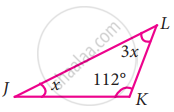Advertisements
Advertisements
प्रश्न
The angles of a triangle are arranged in descending order of their magnitudes. If the difference between two consecutive angles is 10°, find the three angles.
उत्तर
Let one of the angles of a triangle be x. If angles are arranged in descending order. Then, angles will be x, (x – 10°) and (x – 20°).
We know that the sum of all angles in a triangle is equal to 180°
So, x + (x – 10°) + (x – 20°) = 180°
⇒ x + x + x – 30° = 180°
⇒ 3x = 180° + 30°
⇒ 3x = 210°
⇒ x = `210^circ/3` = 70°
Hence, angles will be 70°, 70° – 10° and 70° – 20° i.e., 70°, 60° and 50°.
APPEARS IN
संबंधित प्रश्न
In the following triangle, find the value of x
In a right angled triangle ABC, ∠B is right angle, ∠A is x + 1 and ∠C is 2x + 5. Find ∠A and ∠C
Two adjacent angles are equal. Is it necessary that each of these angles will be a right angle? Justify your answer.
A triangle ABC is right angled at A. L is a point on BC such that AL ⊥ BC. Prove that ∠BAL = ∠ACB.
By which of the following criterion two triangles cannot be proved congruent?
It is possible to have a triangle in which each angle is greater than 60°.
If two triangles are congruent, then the corresponding angles are equal.
The measure of three angles of a triangle are in the ratio 5:3:1. Find the measures of these angles.
If one angle of a triangle is 60° and the other two angles are in the ratio 1:2, find the angles.
In ΔDEF, ∠D = 60°, ∠E = 70° and the bisectors of ∠E and ∠F meet at O. Find (i) ∠F (i) ∠EOF.
